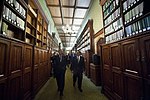House of Commons of the United Kingdom

The House of Commons is the lower house of the Parliament of the United Kingdom. Like the upper house, the House of Lords, it meets in the Palace of Westminster located in London, England. The House of Commons is an elected body consisting of 650 members known as members of Parliament (MPs). MPs are elected to represent constituencies by the first-past-the-post system and hold their seats until Parliament is dissolved. The House of Commons of England started to evolve in the 13th and 14th centuries. In 1707 it became the House of Commons of Great Britain after the political union with Scotland. It assumed the title of "House of Commons of Great Britain and Ireland" after the political union with Ireland at the start of the 19th century. From 1800, the "United Kingdom" referred to was the United Kingdom of Great Britain and Ireland, and in 1922 became the United Kingdom of Great Britain and Northern Ireland after the independence of the Irish Free State. Accordingly, the House of Commons assumed its current title. Under the Parliament Acts 1911 and 1949, the Lords' power to reject legislation was reduced to a delaying power. The government is solely responsible to the House of Commons and the prime minister stays in office only as long as they retain the confidence of a majority of the Commons.
Excerpt from the Wikipedia article House of Commons of the United Kingdom (License: CC BY-SA 3.0, Authors, Images).House of Commons of the United Kingdom
New Palace Yard, London Lambeth
Geographical coordinates (GPS) Address Website Nearby Places Show on map
Geographical coordinates (GPS)
| Latitude | Longitude |
|---|---|
| N 51.499888888889 ° | E -0.12466666666667 ° |
Address
Palace of Westminster (Houses of Parliament)
New Palace Yard
SW1A 0AA London, Lambeth
England, United Kingdom
Open on Google Maps









